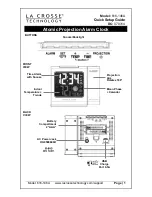
After all detectors have been
installed, test the complete
system to ensure that no
wiring faults exist, and that all
parts of the system operate as
intended. A complete system
checkout consists of testing each detector at its installed
location and following the panel manufacturer’s instruc-
tions for system checkout. Also, refer to NFPA 72 for addi-
tional information.
Where to Place Detectors
Detector placement is critical to early warning functions.
To provide effective early warning of a developing fire sit-
uation, smoke detectors should be installed in all areas of
the protected premises. Total coverage as defined by NFPA
72 should include all rooms, halls, storage areas, base-
ments, attics, lofts, and spaces above suspended ceilings
including plenum areas utilized as part of the HVAC sys-
tem. In addition, this should include all closets, elevator
shafts, enclosed stairways, dumbwaiter shafts, chutes and
other subdivisions and accessible spaces.
Fire detection systems installed to meet local codes or ordi-
nances may not be adequate for early warning of fire.
A
P
P
L
I
C
A
T
I
O
N
S
G
U
I
D
E
:
S
Y
S
T
E
M
S
M
O
K
E
D
E
T
E
C
T
O
R
S
8
Figure 16 is an example of properly connected
smoke detectors provided with pigtails. This
method of termination supervises all wiring to
the point at which it connects to the detector.
Figure 17 shows an incorrect pigtail connec-
tion. This is a form of “T-tapping” discussed
earlier. Note that the conductor between the
wire nut (or splice) and the detector is unsu-
pervised, and could be cut or disconnected
without resulting in a trouble signal.
Wireless Systems
Wireless smoke detectors do not require any
field wiring as the power for the initiating
devices is contained and incorporated within
the device. Removal of a wireless smoke detec-
tor initiates a distinct tamper or trouble signal.
Follow the instructions in the manufacturer’s
installation manual for wireless systems.
Installation Do’s and Don’ts
Do:
• Verify that 2-wire smoke detectors to be
used have been tested and UL listed for
compatibility with the equipment to
which they are connected. If necessary,
contact the manufacturer for this informa-
tion.
• Locate any end-of-line devices electrically
at the end of the circuit, beyond all initi-
ating devices (not at the control unit,
except in a Class A installation).
• Use caution when utilizing 2-wire detec-
tors with integral relays, because they
may require more power than the initiating device cir-
cuit can supply. This could result in the inability of the
relay to control auxiliary equipment to which it is con-
nected.
• When using wireless detectors, follow the manufactur-
er’s installation instructions to assure proper radio
communication between the smoke detector and the
control panel.
• Observe polarity when required.
• Protect detectors against contamination during con-
struction or renovation.
• Carefully follow the manufacturer’s installation
instructions.
Don’t:
• “T-tap” smoke detectors or circuit conductors, except
when specifically permitted by the manufacturer as
part of an intelligent/addressable system.
• Loop uncut installation conductors around screw ter-
minations.
• Exceed the maximum resistance permitted for the ini-
tiating device system.
• Exceed the number of 2-wire detectors allowed on a 2-
wire initiating circuit (specified by UL).
Wiring and System Checkout
As required for all installation wiring of fire alarm systems,
check the detector loop wiring for grounds, short circuits,
and open faults before the system is placed into operation.
Each detector should be tested in accordance with the
manufacturer’s instructions.
When using wireless detectors, verify the radio signal trans-
mission strength in accordance with the installation manual.
Section 4
Proper Detector
Applications,
Placement and
Spacing*
*The guidelines in this section of the guide are adapted from Standards published by the National Fire Protection Association, Quincy,
Massachusetts, USA. These standards include NFPA 72, National Fire Alarm Code; NFPA 70, “National Electrical Code”, Article 760; and NFPA
90A, “Installation of Air Conditioning and Ventilating Systems”.
Smoke
Detector
Wire Nut
Figure 16: Pigtail Connections –
Correct Wiring Method
Figure 17: Pigtail Connections –
Incorrect Wiring Method
Some codes or ordinances have minimum objectives such
as capturing elevators or preventing circulation of smoke
through the HVAC systems instead of early detection of fire.
A user should weigh the costs against the benefits of
installing a complete fire detection system when any detec-
tion system is being installed. The location, quantity and
zoning of detectors should be determined by what objec-
tives are desired rather than the minimum requirements of
any local codes or ordinances.
“Total coverage”, as defined in NFPA 72, is the definition
of a complete fire detection system. In some of the speci-
fied areas of coverage, such as attics, closets, under open
loading docks or platforms, a heat detector may be more
appropriate than a smoke detector. Careful consideration
should be given to the detector manufacturer’s instructions
and the following recommendations in this guide.
In general, when only one detector is required in a room or
space, the detector should be placed as close to the center
of the ceiling as possible. Central location of the detector is
best for sensing fires in any part of the room. If a center
location is not possible, it may be placed no closer than 4
inches from the wall, or if listed for wall mounting, it may
Smoke
Detector
Wire Nut







































